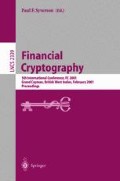Abstract
This paper presents a technique for providing users with anonymity tools without using conventional cryptography. The method, Anonymous Multi Party Computation (AMPC), provides a generic building block for providing electronic anonymity in various applications, e.g., electronic voting and oblivious transfer. It uses a variation of Chaum’s mix-nets that utilizes value-splitting to hide inputs, and hence requires no “conditionally-secure” operations of its users. This is achieved under the assumption that there are secure channels between good participants, and under a suitable resilience threshold assumption that, in our worst adversarial scenario, is a square-root of the system.
Access this chapter
Tax calculation will be finalised at checkout
Purchases are for personal use only
Preview
Unable to display preview. Download preview PDF.
References
J. Benaloh and M. Yung. “Distributing the power of a government to enhance the privacy of voters”. In Proceedings of the 5th ACM Symposium on Principles of Distributed Computing (PODC), pp. 52–62, 1986.
M. Ben-Or, S. Goldwasser, and A. Wigderson. “Completeness theorems for fault-tolerant distributed computing”. In ACM Symposium Theory of Computing (STOC), pp. 1–10, 1988.
J. Bos, B. den Boer. “Detection of disrupters in the DC protocol”. LNCS 434, Advances in Cryptology — EUROCRYPT’97, pp. 320–327, 1990.
G. Brassard and C. Crepeau. “All-or-nothing disclosure of secrets”. LNCS 263, Advances in cryptology — CRYPTO’86, pp. 234–238, 1986.
D. Chaum. “Untraceable electronic mail, return addresses and digital pseudonyms”. Communications of the ACM 24(2):84–88, 1981.
D. Chaum. “Security without identification: Transaction systems to make big brother obsolete”. Communication of the ACM 28(1):1030–1044, 1985.
D. Chaum. “The dining cryptographers problem: Unconditional sender and recipient untraceability”. Journal of Cryptology 1(1):65–75, 1988.
D. Chaum, C. Crepau, and I. Damgard. “Multiparty unconditionally secure protocols”. In Proceedings of the 20th Annual ACM Symposium on the Theory of Computing (STOC), pp. 11–19, 1988.
D. Chaum, S. Roijakkers. “Unconditionally secure digital signatures”. LNCS 537, Advances in cryptology — CRYPTO’90, pp. 206–214, 1991.
R. Cramer, M. Franklin, B. Schoenmakers, and M. Yung. “Multi-authority secret-ballot elections with linear work”. LNCS 1070, Advances in Cryptology — EUROCRYPT’96, pp. 72–83, 1996.
R. Cramer, R. Gennaro, and B. Schoenmakers. “A secure and optimally efficient multi-authority election scheme”. LNCS 1233, Advances in Cryptology-EUROCRYPT’97, pp. 103–118, 1997.
L. F. Cranor and R. K. Cytron. “Sensus: A security-conscious electronic polling system for the Internet”. Proceedings of the Hawai‘i International Conference on System Sciences, 1997, Wailea, Hawaii.
R. DeMillo, N. Lynch, and M. Merritt. “Cryptographic protocols”. Proceedings of the 14th Annual Symposium on the Theory of Computing, pp. 383–400, 1982.
B. Fujioka, T. Okamoto, and K. Ohta. “A Practical Secret Voting Scheme for Large Scale Elections”. LNCS 718, Advances in Cryptology — AUSCRYPT’92, pp. 244–251, 1992.
O. Goldreich. “Secure Multi-party Computation”. Working draft. Available at http://www.wisdom.weizmann.ac.il/~oded/pp.html.
Q. He and Z. Su. “A new practical secure e-voting scheme”. IFIP/SEC’98 14th International Information Security Conference, 1998.
M. Jakobsson. “Flash mixing”. In Proceedings of the Eighteenth Annual ACM Symposium on Principles of Distributed Computing, pp. 83–89, 1999.
M. Naor and B. Pinkas, “Oblivious transfer with adaptive queries”. LNCS 1666, Advances in Cryptology — CRYPTO’99, pp. 573–590, 1999.
H. Nurmi, A. Salomaa, and L. Santean. “Secret ballot elections in computer networks”. Computers & Security, 36(10):553–560, 1991.
T. Pedersen. “Non-interactive and information secure verifiable secret sharing”. LNCS 576, Advances in cryptology — CRYPTO’91, pp. 129–140, 1992.
A. Pfitzmann and M. Waidner. Networks without user observability. Computers & Security 6(2):158–166, 1987.
M. Rabin. “How to exchange secrets by Oblivious transfer”. TR-81 Aileen computation laboratory 1981.
T. Rabin and M. Ben-Or. “Verifiable secret sharing and multiparty protocols with honest majority”. In Proceedings of the 21st ACM Symposium on Theory of Computing (STOC), pp. 73–85, 1989.
M. Reiter and A. Rubin. “Crowds: Anonymity for Web Transactions”. ACM Transactions on Information and System Security, 1(1):66–92, November 1998.
D. Simon and C. Rackoff, ”Non-interactive zero-knowledge proof of knowledge and chosen ciphertext attack”. LNCS 576, Advances in Cryptology-CRYPTO’91, pp. 433–444, 1992.
K. Sako and J. Killian. “Secure voting using partially compatible homomorphisms”. LNCS 839, Advances in Cryptology — CRYPTO’94, pp. 411–424, 1994.
A. Salomaa. “Verifying and recasting secret ballots in computer networks”. LNCS 555, New Results and New Trends in Computer Science, pp. 283–289, 1991.
B. Schoenmakers. “A Simple publicly verifiable secret sharing scheme and its application to electronic voting”. LNCS 1666, Advances in Cryptology — CRYPTO’99, pp. 148–164, 1999.
P. Syverson, D. Goldschlag, and M. Reed. “Anonymous connections and onion routing”. In Proceeding of the IEEE Symposium on security and privacy, 1997.
Author information
Authors and Affiliations
Editor information
Editors and Affiliations
Rights and permissions
Copyright information
© 2002 Springer-Verlag Berlin Heidelberg
About this paper
Cite this paper
Malkhi, D., Pavlov, E. (2002). Anonymity without ‘Cryptography’. In: Syverson, P. (eds) Financial Cryptography. FC 2001. Lecture Notes in Computer Science, vol 2339. Springer, Berlin, Heidelberg. https://doi.org/10.1007/3-540-46088-8_12
Download citation
DOI: https://doi.org/10.1007/3-540-46088-8_12
Published:
Publisher Name: Springer, Berlin, Heidelberg
Print ISBN: 978-3-540-44079-6
Online ISBN: 978-3-540-46088-6
eBook Packages: Springer Book Archive

